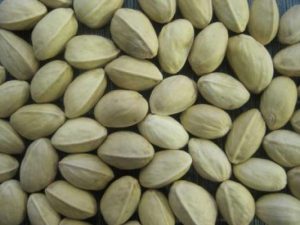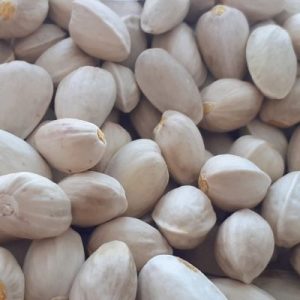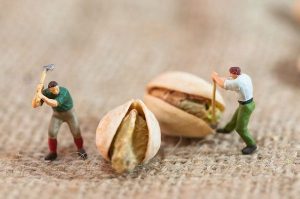The hard shell of the pistachio, properly called shell, undergoes a wonderful transformation at the end of August. The cracking process starts at the tip of the pistachio and gradually spreads towards one or both sides. When these cracks are double-sided and complete, they earn the delightful nickname of smiling pistachios.
closed pistachios
In contrast, closed pistachios that have not yet fully cracked have a lower market value than their grinning counterparts. This value difference tends to decrease as the packed pistachios undergo the cracking process. However, harvesting pistachios can present challenges that result in fewer smiling pistachios and more closed pistachios. Various factors such as weather conditions, unsuitable soil, improper harvesting time and even pest attacks play a role in this.
While closed pistachios may have similar value to their smiling counterparts, their viability in the market needs to be investigated. These pistachios are used in the preparation of various products such as sweets, ice cream, pistachio oil, chips and pistachio powder.
Certain markets specialize in preparing these types of pistachios and subject them to necessary processes such as cooling and additional treatments to prepare them for sale. We will discuss these methods in the following sections. Before doing this, it is necessary to examine the factors that can contribute to pistachios becoming stale or losing their special smile.
Several factors can affect the quality of pistachios and potentially lead to a reduction in their smiling state or their aging. These factors include:
Weather conditions: Unfavorable weather can affect the pistachio crop and affect its quality, causing changes in cracking patterns.
Improper soil: The type of soil in which pistachios are grown can play a role in their overall health and cracking behavior.
Improper harvesting time: Picking pistachios at the wrong time in their ripening cycle can affect cracking and lead to an increased presence of closed or dead pistachios.
Pest attacks: Pest infestations can compromise pistachio quality and affect its appearance and taste.
Understanding these factors is important for pistachio growers and processors and allows them to take actions that increase product quality and market value. In the following sections, we examine the methods used to handle closed-mouth pistachios and ensure their suitability for various applications and markets.

Closed pistachios factors
- Base type: Despite the lack of comprehensive research, early studies point to a potential link between the type of base on which pistachios are planted and their yield percentage. Pistachios produced on domesticated bases showed the least amount of smiling, indicating a relationship that warrants deeper exploration.
- Type of pistachios: Research on different types of pistachios shows differences in the smiling percentage. The variety “Kalle Ghouchi” has the highest percentage of mold, while the varieties “Akbari” and “Fandoghi” are the leaders in pistachio mold. Although these observations are not universally applicable, they provide valuable insights into cultivar characteristics.
- Pollination: Research shows that the use of special male pollen, such as Soltani and Ahmad Aghaei cultivars, has a positive effect on pistachio flowering percentage. Pollination methods can help increase the palatability of pistachios.
- Effect of harvest time: Harvest time appears as a critical factor affecting pistachio percentage. Delayed harvesting, facilitated by multi-stage harvesting with tree shaking, can reduce completely closed pistachios and improve the quality of the final product.
- Adequate irrigation Proper irrigation in certain periods, especially in May and June and approaching the harvest season, significantly affects the freshness and positive growth of pistachios.
- Nutrient supply: Ensuring the timely supply of high-use and low-use elements, including nitrogen, potassium, phosphorus and amino acids, through appropriate nutrition programs, increases the performance of the pistachio tree and accelerates growth.
- Winter pruning: Winter pruning, despite the initial hesitation, helps to properly remove storage nodes, create opportunities for stronger nodes to open and increase the production of quality bunches.
- Effect of thinning: Thinning, the strategic removal of some fruits to increase the size and quality of others, is used to improve pistachio characteristics and increase yield.
- Timely harvest and storage: The moisture in the pistachio affects its appearance. A rapid decrease in humidity can lead to skin wrinkling and increased incidence of small cracks in pistachios.
Understanding and implementing these factors can not only affect the pistachio smiling index, but also contribute to the overall quality and productivity of the pistachio industry.

The method of opening closed pistachios
Use cold water to open pistachios
In this closed pistachios are first placed in cold water for a whole day. Choosing cold water will make the pistachios open and open their mouths more. After 24 hours, the pistachios are removed from the water and placed in the dryer. This device dries and cools pistachios by using heat. It is highly recommended that you carefully read the article that deals with the diagnosis and identification of dried and ready-to-eat pistachios.
Making pistachios smile by heating and cooling them
In this method, pistachios are first transferred to a dryer or dehumidifier so that the temperature reaches the desired level. Then the pistachios are immersed in cold water so that the temperature drops suddenly. In the next step, the pistachios are transferred back to the dryer to dry completely.
This sudden change in temperature causes the pistachio skin to open and the pistachios to smile. This phenomenon is done especially in pistachios that are Ahmad Aghaei and Akbari cultivars, using the method of temperature regulation and the use of cold and hot water.

Conclusion
In addition to the weight, size, type and uniformity of pistachios, the percentage of pistachios with closed pistachios is also effective in determining the portion of pistachios. A standard has been considered for the percentage of pistachios. I consider the defined standard for the percentage of closed pistachios to be 5%. In other words, the lower the percentage and the number of closed pistachios, the higher the quality. For this reason, pistachios whose percentage of closed pistachios is less than 5% can have a higher price and quality. So, the closer this percentage is to zero, the higher the quality of that post
